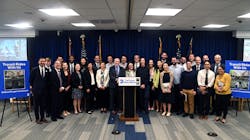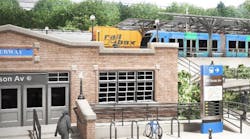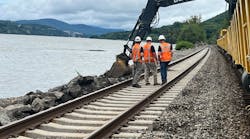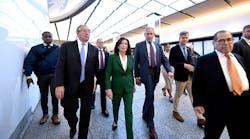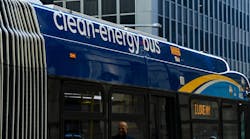MTA outlines plan to rebuild, improve and expand its system over 20 years
The Metropolitan Transportation Authority (MTA) has outlined the authority’s long-term vision to rebuild, improve and expand the region’s $1.5 trillion transit system over the next 20 years. “The Future Rides With Us,” MTA’s 20-Year Needs Assessment, takes a look into the system’s infrastructure needs. It reveals both challenges and opportunities for the future of transportation in the region and lays out an approach to rebuilding the MTA system for another century of service.
MTA says the document differs from previous assessments conducted by the authority by providing a comprehensive, unconstrained view of the system’s needs rather than constraining it to meet an arbitrary budget target. As a result, MTA says the document will serve as a strong foundation in determining how to prioritize capital spending in developing the 2025-2029 Capital Plan. The assessment also debuts a comparative evaluation of potential expansion projects that could be pursued if the system’s rebuilding and improvement needs are met, allowing for potential projects to be analyzed objectively along a host of criteria to compare the projects respective benefits and costs.
“The MTA has never undertaken a 20-Year Needs Assessment fed by this level of comprehensive data and analysis,” said MTA Chair and CEO Janno Lieber. “Instead of matching needs to some pre-approved budget, this detailed evaluation tells the whole story, laying bare the urgent need for renewal and improvement of the system’s existing infrastructure and to prepare for climate change. This is an essential first step to start the discussion that will shape the 2025-2029 MTA Capital Plan.”
“The MTA system is a $1.5 trillion asset and keeping it running is critical to the New York region,” said MTA Construction and Development President Jamie Torres-Springer. “This 20-Year Needs Assessment is the most rigorous assessment in history and will serve as a blueprint for how we can tackle the challenges we face and deliver the future our riders deserve.”
MTA says the level of detail, put together over the course of two years, is unprecedented at this scale, resulting in the most rigorous and transparent 20-Year Needs Assessment in the history of the authority. The authority has looked at every one of the nearly 6 million component assets that comprise the plan, including:
- 8,747 railcars
- 5,840 buses
- 1,907 miles of track
- 1,092 rail bridges
- 704 passenger stations
- 429 power substations
- 101 maintenance shops
- 68 rail yards
- Seven vehicular bridges
- Two vehicular tunnels
The future of the system is contingent on three main factors that drive the need for investment:
- Aging infrastructure
- Climate change
- Evolving rider needs
MTA notes prolonging the life of existing assets will not only improve reliability and allow for increased service systemwide, but enable the opportunity to expand and modernize the transit network.
“RPA applauds the clear rationale for project choice and prioritization in the MTA's 20-Year Needs Assessment,” said MTA Regional Plan Association (RPA) Executive Vice President Kate Slevin. “The work is a reaffirmation that projects like the Interborough Express (IBX) are vital to not only improving commutes, but also to improving equity and serving large numbers of riders. Significant investments in maintaining the current system are of equal if not greater importance in the plan and congestion pricing is a key funding source for them. Upgrading tracks and signals, fortifying the system so the system is ready for intense storms, purchasing new rolling stock and electric buses and making stations more accessible. These are just some of the many “core” projects that are absolutely essential. RPA applauds the MTA for clearly articulating these worthy needs.”
“The Twenty-Year Needs Assessment sets a critical track for essential capital investments in our regional transit network,” said Permanent Citizens Advisory Committee to the MTA Executive Director Lisa Daglian. “It helps lay out where the money from congestion pricing will go in the future: Critical resiliency projects that will protect riders from increasingly frequent extreme weather, new elevators, escalators and ramps across the system to improve accessibility for many more people, state-of-good-repair work so subways, buses and commuter rail keep moving – the literal nuts and bolts of keeping the lights on and the trains running on time. At the same time, ensuring the region is able to grow with expansion projects like IBX and Penn Access is key to keeping us economically competitive and attracting new riders out of their cars and onto transit. Riders and all stakeholders will have an opportunity to offer their input to the next capital plan before it’s released next year and then watch as the vision becomes the reality of the 21st century transit system our 21st century region deserves.”
A few highlights of the need to rebuild and improve:
New York City Transit
- Replacement of aging substations and installing Communications Based Train Control for 90 percent of trips by 2045 will greatly enhance reliability, shorten waiting times and reduce delays.
- Functionally obsolete shops and yards, like the Livonia Yard, need to be reconstructed. The Livonia Maintenance Facility was built 101 years ago and is not capable of servicing new rail cars because they do not fit. This structural limitation prevents running new cars on the 3 line.
- Continued investments in ADA accessibility projects ensure that by 2045, 90 percent of all subway rides take place at fully ADA accessible stations.
- Increase sustainability by converting the largest bus fleet in the country to a zero-emissions fleet by 2040, along with updating the necessary facilities and depot to support the transition. The MTA has also committed to reducing 85 percent of greenhouse gas emissions from its day-to-day operations.
Metro-North Railroad
- Major capital investments are required to reconstruct the Grand Central Train Shed, Park Avenue Tunnel and Park Avenue Viaduct, vital to 98 percent of Metro-North service.
- To protect the Hudson Line from growing climate threats, additional resiliency measures are needed to mitigate and prevent flooding from sea-level rise and heavy rain.
- Platforms at 19 stations on the Harlem Line currently require additional structural support and maintenance due to deteriorating conditions and must be replaced.
Long Island Rail Road (LIRR)
- Due to its aging condition, the Atlantic Avenue Tunnel must be structurally rehabilitated and improved with waterproofing, enhanced lighting, upgraded fire safety and security systems.
- To minimize disruptions to service, 60 to 100 bridges and 11-23 viaducts must be replaced or rehabilitated. Taking the opportunity to apply state-of-the-art protective surface coating and deck waterproofing will decrease future maintenance needs.
- Approximately 50 miles of signal systems need to be upgraded, particularly segments across five LIRR branches, where 50 percent to 75 percent of the signal components are rated poor/ marginal.
- Completion of the Centralized Train Control location will improve operations and communication. The centralized system also replaces train tower control systems located at different points across the LIRR’s service area, reducing operating costs and future capital costs by eliminating the need to maintain towers and their related communication systems.
Bridges & Tunnels
A sustained high level of capital investment similar to current levels is necessary to maintain the facilities in good condition while also improving them to better serve the region and prolong the life of critical structure elements through innovative technologies like cable dehumidification. Cable dehumidification is a proven technique used around the world to minimize corrosion and preserve main cables, which are the primary load-carrying elements for suspension bridges.
System expansion
For the first time, the document includes an evaluation of potential future projects to expand the system comparatively against to one another on a level playing field. The analysis comprehensively considers all projects through a systematic analysis using conservative industry-leading cost estimation and modeling techniques that take into account current and projected changes to costs, ridership and local population shifts. Projects are compared to one another to evaluate potential ridership, cost, travel time, capacity, geographic distribution, equity, resiliency and network leverage.
